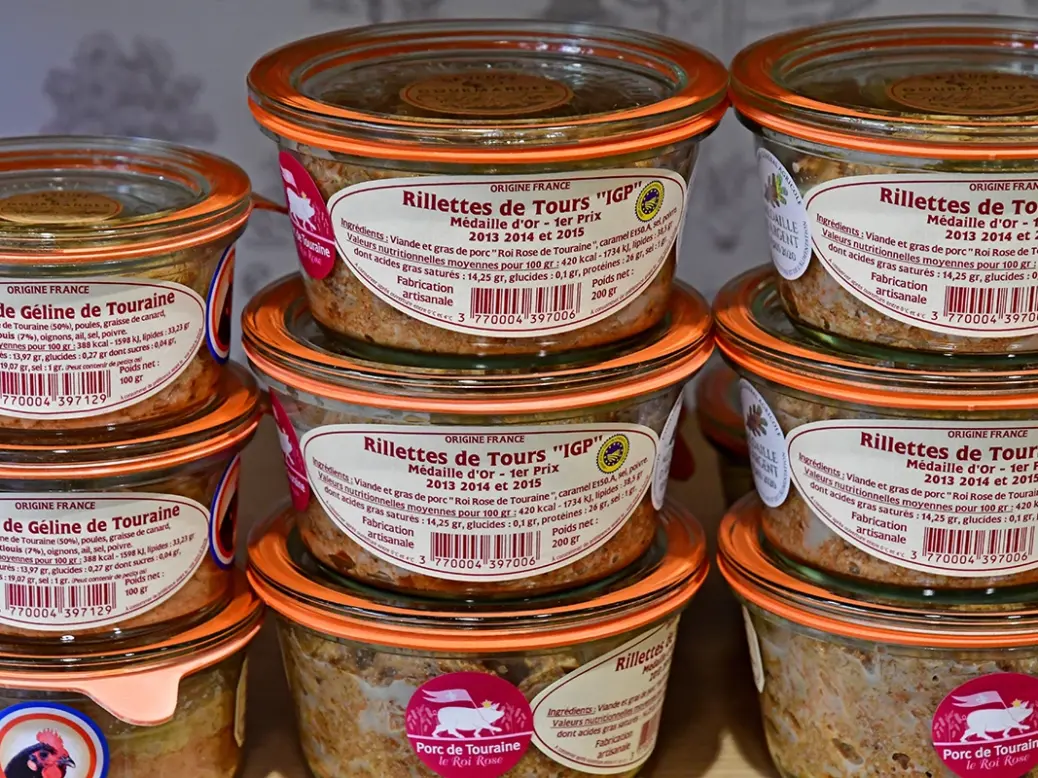
The reputation of rillettes de Tours goes back a long way. Rabelais, who was born in the town of Chinon to the southwest of Tours, referred to rillettes in his satirical Le Tiers Livre of 1546 as brune confiture de cochon, which translates neatly, if not very appetizingly, as “brown pig jam.” Nearly 300 years later, the “brune confiture” of Tours was acclaimed by Balzac in his novel Le Lys dans la Vallée, and Proust refers to the reputation of rillettes de Tours in À la Recherche du Temps Perdu (1913).
Even Astérix almost got in on the act. Goscinny initially included rillettes de Tours in Le Tour de Gaule d’Astérix (1963), in which Astérix and Obelix collect regional culinary specialities for a banquet, but the episode was cut before publication to shorten the book.
The Loire Valley is not alone in having a long history of rillettes—meat slowly cooked in fat from the same animal, shredded then preserved in the fat and packed into pots and served spread thickly on bread. Southwest France is rightly proud of its rillettes d’oie (goose) and de canard (duck)—but none of the other rillettes has the distinction of the Tours product—not even the neighboring rillettes du Mans.
The word rillettes (always used in the plural) originated around Tours and is said to derive from the Old French rille, which dates from the end of the 15th century and referred a thin strips of pork, although it was not until the mid-1800s that rillettes appeared in the universal dictionary.
Most rillettes are named according to their meat, poultry or, increasingly nowadays, fish type. Rillettes de Tours, although always made from pork, takes the name of its place of origin and production instead. The same applies to rillettes du Mans, from the Sarthe department, northwest of Tours, but there’s a crucial difference in status between the two: the Tours product is designated IGP (Indication Géographique Protégée); Le Mans rillettes are not, although the Rillettes Sarthoises Confrérie are hoping it will come.
In fact, rillettes de Tours are the only rillettes with IGP status—awarded in 2013 more than 20 years after the Confrérie began its application. IGP means they must be produced by artisans and salaisonniers (meat curers) in the officially delimited area—20 cantons in and on the borders of the Indre-et-Loire department—and there are production rules to be followed.
The pieces of meat and fat are 100% pork from so-called “noble” cuts (mainly leg and shoulder, but also filet, loin and sometimes belly) and the meat is first browned in the fat on a high heat and then cooked slowly for between 5 hours 30 minutes and 12 hours. A final short period of cooking at high heat gives the the rillettes a characteristic darker color and distinctive slightly browned, caramelised taste. The meat is shredded, or pulled, but also includes some larger pieces of pork. Seasoning is limited to salt without nitrite, pepper and, at the end, a local Chenin Blanc wine such as Vouvray or Chenin eau de vie.
Today, there are about 250 artisan producers. In contrast, the production of rillettes du Mans is more industrialized.
What to drink with rillettes de Tours
In the region, rillettes de Tours are traditionally served with a dry or semi-dry Loire Chenin, such as Vouvray or Montlouis, or with local Cabernet Franc reds such as Chinon, Saint-Nicolas de Bourgueil or Bourgueil. While Chenin cuts through the richness of the rillettes, I find the richness diminishes young Chenins, making them taste thinner and reedier. Venerable old dry wines from ripe vintages, with their the complexity, honeyed depth and continued freshness are a different matter. I very much enjoyed a 1989 Domaine des Aubuisières Vouvray Sec recently.
For me, red wines work better: fresh, light to medium-bodied reds that have relatively low tannin and little or no oak, among them Loire Cabernet Francs, especially Saumurs such as Domaine Filliatreau Saumur-Champigny 2020. Here is a wine that retains its quintessential Loire freshness and Cabernet Franc fruit, while clearly having soaked up the sun and warmth of the vintage.
Other French reds that pair well in a similar way but with added minerality (if I may use that word) are Beaujolais Crus and Marcillac. To give just a few examples: Moulin-à-Vent or Chénas from Domaine du Granit, Morgon Côte du Puy from Domaine Jean-Marc Burgaud, and Domaine du Cros Lo Sang del Pais Marcillac. It is no coincidence that these are the sorts of red wines that go readily with fish.
Outside France, I would head for Italian reds such as young Tuscan Sangioveses and Cerasuolo di Vittoria (another red that is often successful with fish) and Austrian Zweigelt. For the latter, I mean the “ballet dancers” rather than the “body builders” that Sarah Marsh talks of in her recent article.






